Xinyang Yi
Jay
PLUM: Adapting Pre-trained Language Models for Industrial-scale Generative Recommendations
Oct 09, 2025Abstract:Large Language Models (LLMs) pose a new paradigm of modeling and computation for information tasks. Recommendation systems are a critical application domain poised to benefit significantly from the sequence modeling capabilities and world knowledge inherent in these large models. In this paper, we introduce PLUM, a framework designed to adapt pre-trained LLMs for industry-scale recommendation tasks. PLUM consists of item tokenization using Semantic IDs, continued pre-training (CPT) on domain-specific data, and task-specific fine-tuning for recommendation objectives. For fine-tuning, we focus particularly on generative retrieval, where the model is directly trained to generate Semantic IDs of recommended items based on user context. We conduct comprehensive experiments on large-scale internal video recommendation datasets. Our results demonstrate that PLUM achieves substantial improvements for retrieval compared to a heavily-optimized production model built with large embedding tables. We also present a scaling study for the model's retrieval performance, our learnings about CPT, a few enhancements to Semantic IDs, along with an overview of the training and inference methods that enable launching this framework to billions of users in YouTube.
STAR: A Simple Training-free Approach for Recommendations using Large Language Models
Oct 21, 2024Abstract:Recent progress in large language models (LLMs) offers promising new approaches for recommendation system (RecSys) tasks. While the current state-of-the-art methods rely on fine-tuning LLMs to achieve optimal results, this process is costly and introduces significant engineering complexities. Conversely, methods that bypass fine-tuning and use LLMs directly are less resource-intensive but often fail to fully capture both semantic and collaborative information, resulting in sub-optimal performance compared to their fine-tuned counterparts. In this paper, we propose a Simple Training-free Approach for Recommendation (STAR), a framework that utilizes LLMs and can be applied to various recommendation tasks without the need for fine-tuning. Our approach involves a retrieval stage that uses semantic embeddings from LLMs combined with collaborative user information to retrieve candidate items. We then apply an LLM for pairwise ranking to enhance next-item prediction. Experimental results on the Amazon Review dataset show competitive performance for next item prediction, even with our retrieval stage alone. Our full method achieves Hits@10 performance of +23.8% on Beauty, +37.5% on Toys and Games, and -1.8% on Sports and Outdoors relative to the best supervised models. This framework offers an effective alternative to traditional supervised models, highlighting the potential of LLMs in recommendation systems without extensive training or custom architectures.
Leveraging LLM Reasoning Enhances Personalized Recommender Systems
Jul 22, 2024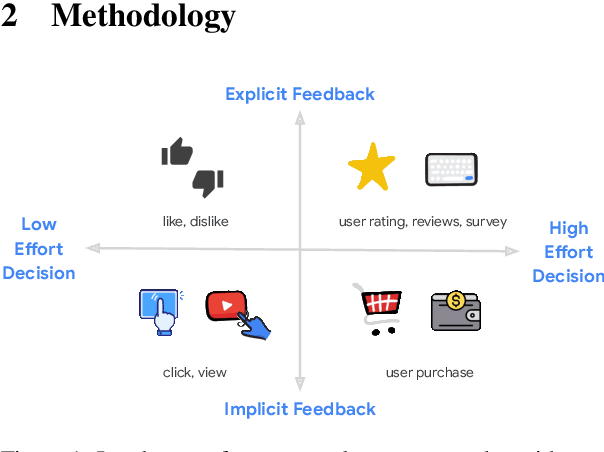



Abstract:Recent advancements have showcased the potential of Large Language Models (LLMs) in executing reasoning tasks, particularly facilitated by Chain-of-Thought (CoT) prompting. While tasks like arithmetic reasoning involve clear, definitive answers and logical chains of thought, the application of LLM reasoning in recommendation systems (RecSys) presents a distinct challenge. RecSys tasks revolve around subjectivity and personalized preferences, an under-explored domain in utilizing LLMs' reasoning capabilities. Our study explores several aspects to better understand reasoning for RecSys and demonstrate how task quality improves by utilizing LLM reasoning in both zero-shot and finetuning settings. Additionally, we propose RecSAVER (Recommender Systems Automatic Verification and Evaluation of Reasoning) to automatically assess the quality of LLM reasoning responses without the requirement of curated gold references or human raters. We show that our framework aligns with real human judgment on the coherence and faithfulness of reasoning responses. Overall, our work shows that incorporating reasoning into RecSys can improve personalized tasks, paving the way for further advancements in recommender system methodologies.
Aligning Large Language Models with Recommendation Knowledge
Mar 30, 2024



Abstract:Large language models (LLMs) have recently been used as backbones for recommender systems. However, their performance often lags behind conventional methods in standard tasks like retrieval. We attribute this to a mismatch between LLMs' knowledge and the knowledge crucial for effective recommendations. While LLMs excel at natural language reasoning, they cannot model complex user-item interactions inherent in recommendation tasks. We propose bridging the knowledge gap and equipping LLMs with recommendation-specific knowledge to address this. Operations such as Masked Item Modeling (MIM) and Bayesian Personalized Ranking (BPR) have found success in conventional recommender systems. Inspired by this, we simulate these operations through natural language to generate auxiliary-task data samples that encode item correlations and user preferences. Fine-tuning LLMs on such auxiliary-task data samples and incorporating more informative recommendation-task data samples facilitates the injection of recommendation-specific knowledge into LLMs. Extensive experiments across retrieval, ranking, and rating prediction tasks on LLMs such as FLAN-T5-Base and FLAN-T5-XL show the effectiveness of our technique in domains such as Amazon Toys & Games, Beauty, and Sports & Outdoors. Notably, our method outperforms conventional and LLM-based baselines, including the current SOTA, by significant margins in retrieval, showcasing its potential for enhancing recommendation quality.
Density Weighting for Multi-Interest Personalized Recommendation
Aug 03, 2023



Abstract:Using multiple user representations (MUR) to model user behavior instead of a single user representation (SUR) has been shown to improve personalization in recommendation systems. However, the performance gains observed with MUR can be sensitive to the skewness in the item and/or user interest distribution. When the data distribution is highly skewed, the gains observed by learning multiple representations diminish since the model dominates on head items/interests, leading to poor performance on tail items. Robustness to data sparsity is therefore essential for MUR-based approaches to achieve good performance for recommendations. Yet, research in MUR and data imbalance have largely been done independently. In this paper, we delve deeper into the shortcomings of MUR inferred from imbalanced data distributions. We make several contributions: (1) Using synthetic datasets, we demonstrate the sensitivity of MUR with respect to data imbalance, (2) To improve MUR for tail items, we propose an iterative density weighting scheme (IDW) with user tower calibration to mitigate the effect of training over long-tail distribution on personalization, and (3) Through extensive experiments on three real-world benchmarks, we demonstrate IDW outperforms other alternatives that address data imbalance.
Online Matching: A Real-time Bandit System for Large-scale Recommendations
Jul 29, 2023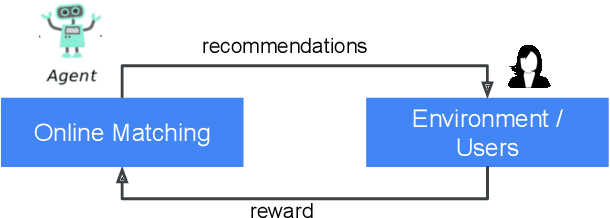

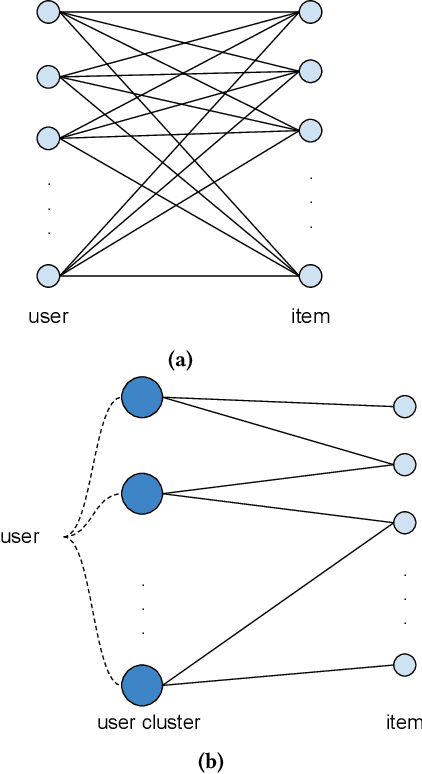

Abstract:The last decade has witnessed many successes of deep learning-based models for industry-scale recommender systems. These models are typically trained offline in a batch manner. While being effective in capturing users' past interactions with recommendation platforms, batch learning suffers from long model-update latency and is vulnerable to system biases, making it hard to adapt to distribution shift and explore new items or user interests. Although online learning-based approaches (e.g., multi-armed bandits) have demonstrated promising theoretical results in tackling these challenges, their practical real-time implementation in large-scale recommender systems remains limited. First, the scalability of online approaches in servicing a massive online traffic while ensuring timely updates of bandit parameters poses a significant challenge. Additionally, exploring uncertainty in recommender systems can easily result in unfavorable user experience, highlighting the need for devising intricate strategies that effectively balance the trade-off between exploitation and exploration. In this paper, we introduce Online Matching: a scalable closed-loop bandit system learning from users' direct feedback on items in real time. We present a hybrid "offline + online" approach for constructing this system, accompanied by a comprehensive exposition of the end-to-end system architecture. We propose Diag-LinUCB -- a novel extension of the LinUCB algorithm -- to enable distributed updates of bandits parameter in a scalable and timely manner. We conduct live experiments in YouTube and show that Online Matching is able to enhance the capabilities of fresh content discovery and item exploration in the present platform.
Better Generalization with Semantic IDs: A case study in Ranking for Recommendations
Jun 13, 2023Abstract:Training good representations for items is critical in recommender models. Typically, an item is assigned a unique randomly generated ID, and is commonly represented by learning an embedding corresponding to the value of the random ID. Although widely used, this approach have limitations when the number of items are large and items are power-law distributed -- typical characteristics of real-world recommendation systems. This leads to the item cold-start problem, where the model is unable to make reliable inferences for tail and previously unseen items. Removing these ID features and their learned embeddings altogether to combat cold-start issue severely degrades the recommendation quality. Content-based item embeddings are more reliable, but they are expensive to store and use, particularly for users' past item interaction sequence. In this paper, we use Semantic IDs, a compact discrete item representations learned from content embeddings using RQ-VAE that captures hierarchy of concepts in items. We showcase how we use them as a replacement of item IDs in a resource-constrained ranking model used in an industrial-scale video sharing platform. Moreover, we show how Semantic IDs improves the generalization ability of our system, without sacrificing top-level metrics.
Improving Training Stability for Multitask Ranking Models in Recommender Systems
Feb 17, 2023



Abstract:Recommender systems play an important role in many content platforms. While most recommendation research is dedicated to designing better models to improve user experience, we found that research on stabilizing the training for such models is severely under-explored. As recommendation models become larger and more sophisticated, they are more susceptible to training instability issues, \emph{i.e.}, loss divergence, which can make the model unusable, waste significant resources and block model developments. In this paper, we share our findings and best practices we learned for improving the training stability of a real-world multitask ranking model for YouTube recommendations. We show some properties of the model that lead to unstable training and conjecture on the causes. Furthermore, based on our observations of training dynamics near the point of training instability, we hypothesize why existing solutions would fail, and propose a new algorithm to mitigate the limitations of existing solutions. Our experiments on YouTube production dataset show the proposed algorithm can significantly improve training stability while not compromising convergence, comparing with several commonly used baseline methods.
Empowering Long-tail Item Recommendation through Cross Decoupling Network (CDN)
Oct 25, 2022Abstract:Recommenders provide personalized content recommendations to users. They often suffer from highly skewed long-tail item distributions, with a small fraction of the items receiving most of the user feedback. This hurts model quality especially for the slices without much supervision. Existing work in both academia and industry mainly focuses on re-balancing strategies (e.g., up-sampling and up-weighting), leveraging content features, and transfer learning. However, there still lacks of a deeper understanding of how the long-tail distribution influences the recommendation performance. In this work, we theoretically demonstrate that the prediction of user preference is biased under the long-tail distributions. This bias comes from the discrepancy of both the prior and conditional probabilities between training data and test data. Most existing methods mainly attempt to reduce the bias from the prior perspective, which ignores the discrepancy in the conditional probability. This leads to a severe forgetting issue and results in suboptimal performance. To address the problem, we design a novel Cross Decoupling Network (CDN) to reduce the differences in both prior and conditional probabilities. Specifically, CDN (i) decouples the learning process of memorization and generalization on the item side through a mixture-of-expert structure; (ii) decouples the user samples from different distributions through a regularized bilateral branch network. Finally, a novel adapter is introduced to aggregate the decoupled vectors, and softly shift the training attention to tail items. Extensive experimental results show that CDN significantly outperforms state-of-the-art approaches on popular benchmark datasets, leading to an improvement in HR@50 (hit ratio) of 8.7\% for overall recommendation and 12.4\% for tail items.
Reward Shaping for User Satisfaction in a REINFORCE Recommender
Sep 30, 2022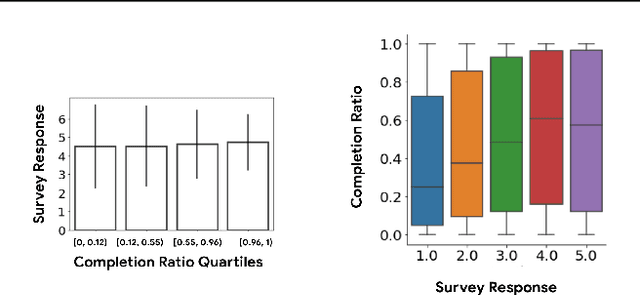
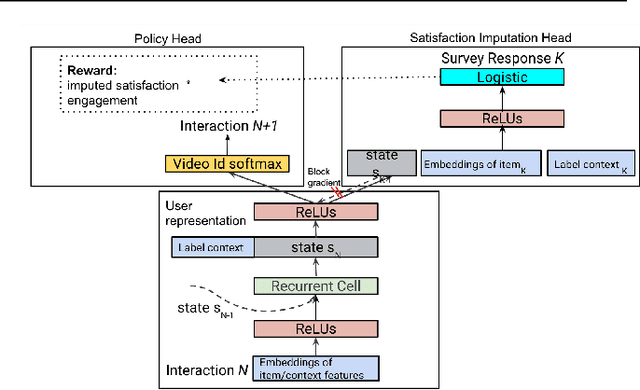
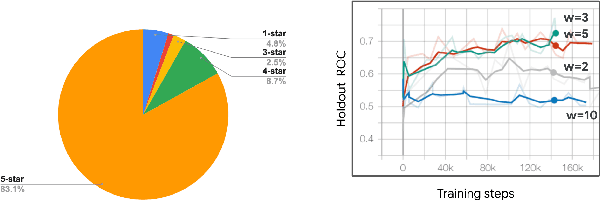

Abstract:How might we design Reinforcement Learning (RL)-based recommenders that encourage aligning user trajectories with the underlying user satisfaction? Three research questions are key: (1) measuring user satisfaction, (2) combatting sparsity of satisfaction signals, and (3) adapting the training of the recommender agent to maximize satisfaction. For measurement, it has been found that surveys explicitly asking users to rate their experience with consumed items can provide valuable orthogonal information to the engagement/interaction data, acting as a proxy to the underlying user satisfaction. For sparsity, i.e, only being able to observe how satisfied users are with a tiny fraction of user-item interactions, imputation models can be useful in predicting satisfaction level for all items users have consumed. For learning satisfying recommender policies, we postulate that reward shaping in RL recommender agents is powerful for driving satisfying user experiences. Putting everything together, we propose to jointly learn a policy network and a satisfaction imputation network: The role of the imputation network is to learn which actions are satisfying to the user; while the policy network, built on top of REINFORCE, decides which items to recommend, with the reward utilizing the imputed satisfaction. We use both offline analysis and live experiments in an industrial large-scale recommendation platform to demonstrate the promise of our approach for satisfying user experiences.
 Add to Chrome
Add to Chrome Add to Firefox
Add to Firefox Add to Edge
Add to Edge